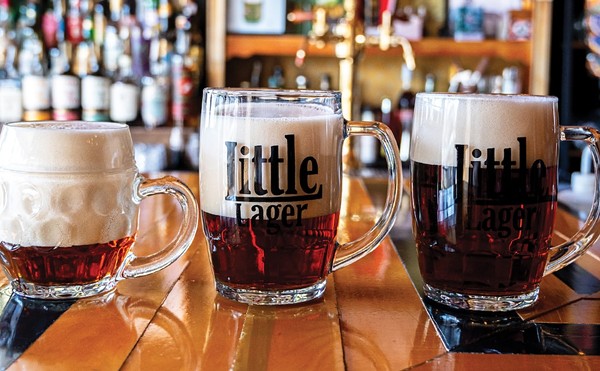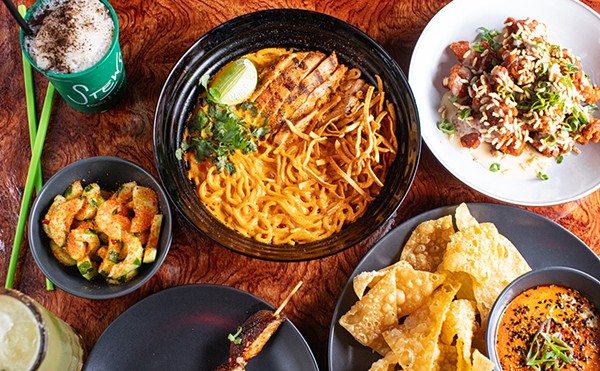Back in February of 1980, Japanese food was virtually unknown in these parts. Robata, featuring the teppan style of tabletop performance-art cooking, was gaining a following, but perish the thought that we Midwesterners might take a liking to raw fish. A sushi bar? Tachibana may or may not have had the first in this area -- I'm not old enough to remember whether the Mikado had one -- but it certainly was responsible for helping to build the local audience.
Tachibana is the Japanese and botanical name for a mandarin orange, and it's also the name of a temple in the Asuka region that's reputed to be the birthplace of the ancient sage Shotoku in the sixth century. The St. Louis version has always stood out architecturally by virtue of the raised center area in the dining room, topped by exposed, curved beams, not unlike a small culinary temple in and of itself.
And another historical tidbit: Tachibana was the first local outpost to feature the artistry of sushi chef Noboru Kidera, better known as Nobu, who moved on to his own eponymous restaurant in a little storefront on Delmar Boulevard in the late '80s, only to later prove that there's enough similarity between an International House of Pancakes and a pagoda that it's not so weird to turn an IHOP into a Japanese restaurant.
Because we live out that way, we've long treated Tachibana as a fun neighborhood joint, both as a family outing to one of the tatami-lined, paper-walled booths and as a quick traditional-Japanese nosh for my wife and me. But we realized recently that I hadn't written about Tachibana for at least a decade, so we decided to go back and subject it to a more critical eye.
The verdict: Our old standby is as friendly and popular as ever -- and still a great value -- but it could really use a makeover.
On our first visit, I made a mental footnote not to bring the kids back if I had any hope at all of convincing them to clean their rooms. Whereas I associate most things Japanese with an elegance bordering on austerity, Tachibana somewhere along the line became afflicted with clutter, with boxes haphazardly stacked in various places throughout the restaurant. On closer inspection, we noted other truly incongruous items -- three large bottles of vitamins and a can of Lysol, for example -- left randomly around the dining area. The carpet was badly worn; the sushi bar's lacquered wood was wearing away; someone's little darling had decided to pencil all over the paper walls of our booth; and the drink-bar area was adorned with, of all things, a bunch of Imo's magnets.
On the positive side, when the first order of sushi showed up, it was the same as ever, making it almost possible to block out everything around us and focus on the simple, straightforward elegance of the jewel-like slices of fish. The maguro (tuna) that evening was a stunning translucent cranberry-juice shade, and toro (the fattier part of the tuna) was also available -- slightly softer to the bite, with a richer and more complex flavor. Shimesaba (mackerel) still had brightly mirrored skin on one side and was decorated with a dainty tidbit of grated fresh ginger. Among the more adventurous stuff, the sweet (raw) shrimp, ama-ebi, included a fresh, deep fried fish head if we wanted to indulge. For a milder touch, the mainly white-colored fish tai (snapper) and hirame (halibut) were also very good.
Among the maki (rolled) sushi, the nori seaweed wrapping was very crisp and fresh, but if you're expecting your California roll to be made "inside out," with the rice on the outside of the wrapper, the current version at Tachibana doesn't oblige. If you want to depart from the ordinary, try the maki made from umeshiso -- a.k.a. beefsteak plant, a.k.a. rattlesnake weed -- which has a singular pickled-herb taste.
Sushi and sashimi are also offered in 10 combinations, but they're by no means the only thing available at Tachibana. Entrées, almost entirely in the under-$10 range, include tempura (battered and fried seafood and vegetables), donburi (steamed-rice bowls), udon (noodle dishes) and a variety of pork, beef, chicken and seafood specialties.
Because of the amount of sushi we ordered, we only got to three of the entrée dishes on our visits: swordfish teriyaki, nabeyaki udon and shabu-shabu. The name of the latter dish, which means "swish-swish," is derived from the way you move thin slices of beef around in a small kettle of boiling broth that's also flavored with tofu, rice noodles, spinach, mushrooms and quite a bit of cabbage. After cooking the beef, you dip it a sauce based on ponzu, a citrus-enhanced soy sauce.
The nabeyaki udon included hearty worm-size noodles and a slightly richer broth that included shrimp, chicken, crab-textured processed fish and egg -- a nicely filling noodle dish, not terribly complicated. The swordfish was about a 6-ounce fillet -- moist to start and further moistened with a sweet teriyaki sauce -- served simply with a ginger-sesame-dressed lettuce salad and rice.
Also on the menu are about a half-dozen items that can serve as appetizers or sides, including skewers of chicken yakitori, a smaller order of tempura (that's still a good bit of food, with two shrimp and half-a-dozen vegetables), Japanese-style miniature barbecue beef ribs and kushiyaki, three skewered shrimp with pieces of bacon fused to them.
Service is terrifically friendly, from the requisite "Iras-shai!" when you walk in the door to lessons, if necessary, in swish-swishing your shabu-shabu or cutting your swordfish with chopsticks. (The staff doesn't frown on requests for Western utensils.) Still, we sure would have preferred to not see the paper sushi menus tossed over the top of sushi orders as they were delivered, or Styrofoam containers stacked at odd angles along with serving plates behind the sushi bar or any other instances of lack of order that lent a too-casual air to a culture and cuisine that prides itself on being just so.





